
The Royal Navy (RN) is the naval warfare force of the United Kingdom, British Overseas Territories and Crown Dependencies, and a component of His Majesty's Naval Service. Although warships were used by English and Scottish kings from the early medieval period, the first major maritime engagements were fought in the Hundred Years' War against France. The modern Royal Navy traces its origins to the early 16th century; the oldest of the UK's armed services, it is consequently known as the Senior Service.

The Type 23 frigate or Duke class is a class of frigates built for the United Kingdom's Royal Navy. The ships are named after British Dukes, thus leading to the class being commonly known as the Duke class. The first Type 23, HMS Norfolk, was commissioned in 1989, and the sixteenth, HMS St Albans was commissioned in June 2002. They form the core of the Royal Navy's destroyer and frigate fleet and serve alongside the Type 45 destroyers. They were designed for anti-submarine warfare, but have been used for a range of uses. Nine Type 23 frigates remain in service with the Royal Navy, with three vessels having been sold to the Chilean Navy, one being retired in 2021, and three more being retired up to 2024.

HMS Ocean was a Landing Platform Helicopter, formerly the UK's helicopter carrier and the fleet flagship of the Royal Navy. She was designed to support amphibious landing operations and to support the staff of Commander UK Amphibious Force and Commander UK Landing Force. She was constructed in the mid-1990s by Kvaerner Govan on the River Clyde and fitted out by VSEL at Barrow-in-Furness prior to trials and subsequent acceptance in service. Ocean was commissioned in September 1998 at her home port HMNB Devonport, Plymouth.

HMSM33 is an M29-class monitor of the Royal Navy. Built in 1915, she saw active service in the Mediterranean during the First World War and in Russia during the Allied Intervention in 1919. She was used subsequently as a mine-laying training ship, fuelling hulk, boom defence workshop and floating office, being renamed HMS Minerva and Hulk C23 during her long life. She passed to Hampshire County Council in the 1980s and was then handed over to the National Museum of the Royal Navy in 2014. A programme of conservation was undertaken to enable her to be opened to the public. HMS M33 is located within Portsmouth Historic Dockyard and opened to visitors on 7 August 2015 following a service of dedication. She is one of only three surviving Royal Navy warships of the First World War and the only surviving Allied ship from the Gallipoli Campaign, the other being the Ottoman minelayer Nusret, preserved in Çanakkale.
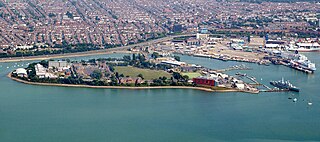
HMS Excellent is a Royal Navy "stone frigate" sited on Whale Island near Portsmouth in Hampshire. HMS Excellent is itself part of the Maritime Warfare School, with a headquarters at HMS Collingwood, although a number of lodger units are resident within the site including the offices of the First Sea Lord.

His Majesty's Naval Base, Clyde, primarily sited at Faslane on the Gare Loch, is one of three operating bases in the United Kingdom for the Royal Navy. It is the navy's headquarters in Scotland and is best known as the home of Britain's nuclear weapons, in the form of nuclear submarines armed with Trident missiles.

The Commander United Kingdom Strike Force is a senior post in the Royal Navy.

The Royal Navy Submarine Museum at Gosport is a maritime museum tracing the international history of submarine development from the age of Alexander the Great to the present day, and particularly the history of the Royal Navy Submarine Service from the navy's first submarine, Holland 1, to the nuclear-powered Vanguard-class submarines. The museum is located close to the former shore establishment HMS Dolphin, the home of the Royal Navy Submarine Service from 1904 until 1999.
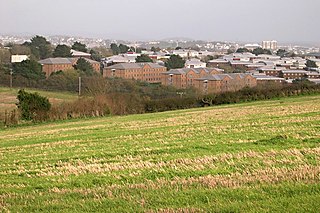
HMS Raleigh is a stone frigate, serving as the basic training facility of the Royal Navy at Torpoint, Cornwall, United Kingdom. It is spread over several square miles, and has damage control simulators and fire-fighting training facilities, as well as a permanently moored training ship, the former HMS Brecon. Its principal function is the delivery of both New Entry Training and Basic Training.

Southwick House is a Grade II listed 19th-century manor house of the Southwick Estate in Hampshire, England, about 5 miles (8 km) north of Portsmouth. It is home to the Defence School of Policing and Guarding, and related military police capabilities.
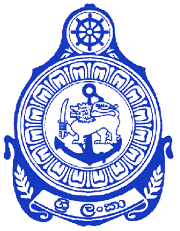
The Sri Lanka Navy (SLN) is the naval arm of the Sri Lanka Armed Forces and is classed as the country's most vital defence force due to its island geography. It is responsible for the maritime defence of the Sri Lankan nation and its interests. The role of the Sri Lanka Navy is to conduct operations at sea for the defence of the nation and its interests and conduct prompt and sustainable combat operations at sea in accordance with the national policies.

HMS Collingwood is a stone frigate of the Royal Navy, in Fareham, England. It is the lead establishment of the Maritime Warfare School and the largest naval training organisation in Western Europe. The Maritime Warfare School is a federated training establishment incorporating HMS Excellent, the Defence Diving School, the RN Physical Training School, the School of Hydrography and Meteorology in Plymouth and the Royal Marines School of Music in Portsmouth Naval Base.
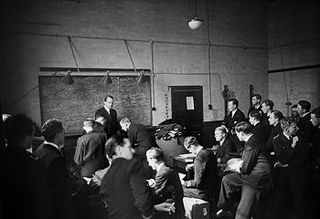
HMS Vernon was a shore establishment or "stone frigate" of the Royal Navy in Portsmouth. Vernon was established on 26 April 1876, as the Royal Navy's Torpedo Branch also known as the Torpedo School, named after the ship HMS Vernon which served as part of its floating base. After the First World War, HMS Vernon moved ashore, taking over the Gunwharf site, where it continued to operate until 1 April 1996, when the various elements comprising the establishment were split up and moved to different commands.

HMS Mercury was a shore establishment of the Royal Navy, and the site of the Royal Navy Signals School and Combined Signals School. There was also a subsidiary branch, HMS Mercury II.

Admiral Sir George Michael Zambellas, is a British retired Royal Navy officer. He was the First Sea Lord and Chief of the Naval Staff from April 2013 until he handed over duties to Admiral Sir Philip Jones in April 2016.

HMS King Alfred is a Royal Naval Reserve shore establishment in Portsmouth, England. The unit has a complement of over 200 reservists and provides training facilities to other lodger units, including the local Royal Marines Reserve (RMR) City of London, and local University Royal Naval Unit (URNU).

703 Naval Air Squadron of the Fleet Air Arm of the Royal Navy was formed as a long-range catapult squadron on 3 March 1942 at RNAS Lee-on-Solent. During the Cold War, it was reformed as an experimental trials unit, and then as a helicopter training squadron. Since 2003, the squadron has formed the Royal Naval wing of the Defence Elementary Flying Training School at RAF Barkston Heath.

Admiral Sir Philip Andrew Jones, is a retired senior Royal Navy officer. After service in the South Atlantic in 1982 during the Falklands War, he commanded the frigates HMS Beaver and HMS Coventry. He went on to be Flag Officer, Scotland, Northern England and Northern Ireland, Commander United Kingdom Maritime Forces and Assistant Chief of the Naval Staff before being appointed Fleet Commander and Deputy Chief of the Naval Staff. Jones served as First Sea Lord from April 2016 to June 2019.
A principal warfare officer (PWO), is one of a number of warfare branch specialist officers.
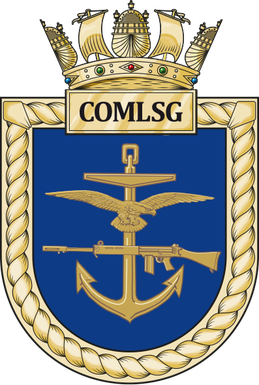
The Commander Littoral Strike Group (COMLSG) is a senior British Royal Navy Amphibious warfare appointment. COMLSG, who is based in Stonehouse Barracks, Stonehouse, Plymouth, reports to Commander United Kingdom Strike Force. It was first established in 1971 as Commodore Amphibious Warfare.



















